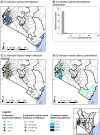Monitoring and evaluating the impact of national school-based deworming in Kenya: study design and baseline results
- PMID: 23829767
- PMCID: PMC3723516
- DOI: 10.1186/1756-3305-6-198
Monitoring and evaluating the impact of national school-based deworming in Kenya: study design and baseline results
Abstract
Background: An increasing number of countries in Africa and elsewhere are developing national plans for the control of neglected tropical diseases. A key component of such plans is school-based deworming (SBD) for the control of soil-transmitted helminths (STHs) and schistosomiasis. Monitoring and evaluation (M&E) of national programmes is essential to ensure they are achieving their stated aims and to evaluate when to reduce the frequency of treatment or when to halt it altogether. The article describes the M&E design of the Kenya national SBD programme and presents results from the baseline survey conducted in early 2012.
Methods: The M&E design involves a stratified series of pre- and post-intervention, repeat cross-sectional surveys in a representative sample of 200 schools (over 20,000 children) across Kenya. Schools were sampled based on previous knowledge of STH endemicity and were proportional to population size. Stool (and where relevant urine) samples were obtained for microscopic examination and in a subset of schools; finger-prick blood samples were collected to estimate haemoglobin concentration. Descriptive and spatial analyses were conducted. The evaluation measured both prevalence and intensity of infection.
Results: Overall, 32.4% of children were infected with at least one STH species, with Ascaris lumbricoides as the most common species detected. The overall prevalence of Schistosoma mansoni was 2.1%, while in the Coast Province the prevalence of S. haematobium was 14.8%. There was marked geographical variation in the prevalence of species infection at school, district and province levels. The prevalence of hookworm infection was highest in Western Province (25.1%), while A. lumbricoides and T. trichiura prevalence was highest in the Rift Valley (27.1% and 11.9%). The lowest prevalence was observed in the Rift Valley for hookworm (3.5%), in the Coast for A. lumbricoides (1.0%), and in Nyanza for T. trichiura (3.6%). The prevalence of S. mansoni was most common in Western Province (4.1%).
Conclusions: The current findings are consistent with the known spatial ecology of STH and schistosome infections and provide an important empirical basis on which to evaluate the impact of regular mass treatment through the school system in Kenya.
Figures








References
-
- Murray CJ, Vos T, Lozano R, Naghavi M, Flaxman AD, Michaud C, Ezzati M, Shibuya K, Salomon JA, Abdalla S. et al.Disability-adjusted life years (DALYs) for 291 diseases and injuries in 21 regions, 1990–2010: a systematic analysis for the Global Burden of Disease Study 2010. Lancet. 2013;380:2197–2223. - PubMed
-
- World Health Organization Expert Committee. Prevention and control of schistosomiasis and soil-transmitted helminthiasis. World Health Organ Tech Rep Ser. 2002;912:1–57. - PubMed
-
- King CH, Lombardi G, Lombardi C, Greenblatt R, Hodder S, Kinyanjui H, Ouma J, Odiambo O, Bryan PJ, Muruka J. et al.Chemotherapy-based control of schistosomiasis haematobia. II. Metrifonate vs. praziquantel in control of infection-associated morbidity. AmJTrop Med Hyg. 1990;42:587–595. - PubMed
-
- Magnussen P, Ndawi B, Sheshe AK, Byskov J, Mbwana K, Christensen NO. The impact of a school health programme on the prevalence and morbidity of urinary schistosomiasis in Mwera Division, Pangani District, Tanzania. Trans R Soc Trop Med Hyg. 2001;95:58–64. - PubMed
-
- Miguel EA, Kremer M. Worms: Identifying Impacts on Education and Health in the Presence of Treatment Externalities. Econometrica. 2004;72:159–217.
Publication types
MeSH terms
Substances
Grants and funding
LinkOut - more resources
Full Text Sources
Other Literature Sources

